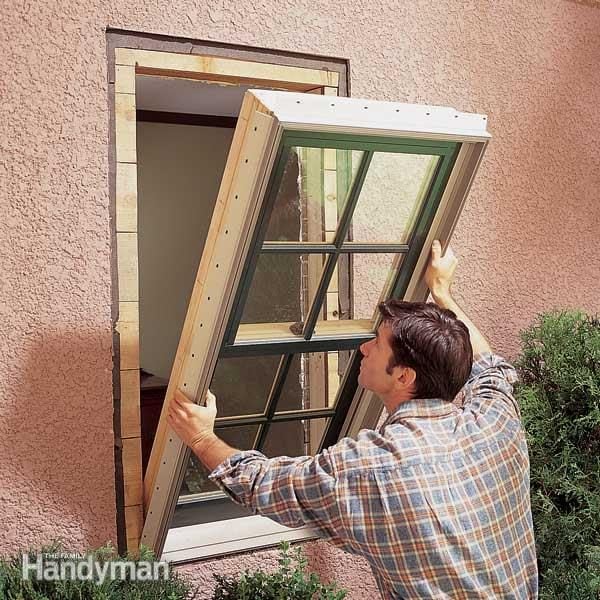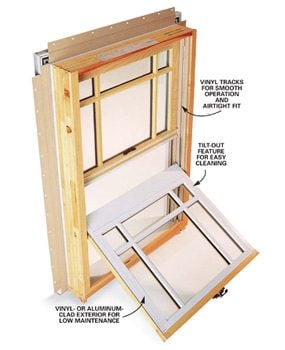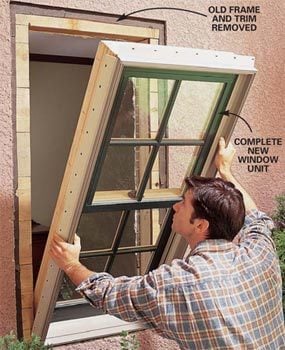FAQs About Buying New Windows
How to evaluate your old windows and select new ones

By the DIY experts of The Family Handyman Magazine
You might also like: TBD
Repair or replace?
New Window
New windows offer a host of benefits-smooth operation, low maintenance, fewer drafts, easier cleaning and modest energy savings. But they’re expensive, so evaluate the repair and maintenance options for your old windows before taking the plunge.
Tough question. New windows are tempting because they offer so much—smoother operation, lower maintenance, energy savings, fewer drafts and easier cleaning. But they’re expensive, and pros charge almost as much as the cost of the windows to install them, which is a major investment.
Ask yourself the following three questions to evaluate your old windows and weigh the benefits of new ones.
1. Are your old windows a hassle?
Are you sick and tired of nursing your windows along, or are you OK with the minor maintenance jobs that go along with them? Consider:
- Ease of operation. Do they lift, swing or slide easily, or do you hesitate to open them when you want ventilation?
- Scraping and painting. Painted windows require regular maintenance. Otherwise they’ll rot and fall apart. New windows with aluminum or vinyl cladding or that are made from vinyl or a composite eliminate this chore.
- Condensation. Does condensation regularly collect on the glass, cloud the view and soak the window trim? Higher-efficiency glass in new windows will help reduce this problem.
- Storm windows. Do you mind cleaning, maintaining and putting up and taking down storm windows? Do your storms need replacement?
- Cleaning. Is this so difficult that you avoid doing it? Many new windows are designed to make cleaning a snap.
2. Are your old windows comfortable?
Single-pane windows often leave rooms feeling chilly and dry in cold weather and overheated in warm, sunny weather. Windows with double-pane glass can greatly improve the comfort of your home. They can block much of the heat of direct sunlight but still allow the light to come through (less need for shades). They’ll reduce cold drafts and the chill of cold glass. And they’ll reduce condensation so you can keep the indoor humidity at a higher, more comfortable level in cold weather. New energy-efficient windows will also save on your fuel bills but rarely enough to justify the investment if your old windows are still in good shape.
3. Are your old windows worth repairing?
You can almost always repair and restore old windows if you’re willing to set aside the time and can find replacement hardware. But it’s not always worth the effort and expense. Major problems include:
- Rot. Once rot starts, it’s tough to stop unless you commit yourself to replacing rotted wood (a difficult job) and then maintaining it regularly. Consider replacement.
- Sagging casement (crank-out) windows. You can usually replace worn-out crank mechanisms, but bent or worn hinges are tougher and replacements don’t always solve the problem. Consider new windows.
- Fogged double-pane glass. The fogging that occurs between the glass panes can’t be fixed. Glass replacement (sometimes the entire sash) is the only solution. This is often difficult and it’s expensive if a pro does it. Compare the “fix-it” cost with the cost of a new window.
- Hard-to-find replacement hardware. Call the window manufacturer or local window dealer if you can identify the window brand and model number. Many hard-to-find parts are available from online suppliers. But often new windows are the only option.
What’s the best way to replace my windows?
Wood or vinyl window inserts cost about the same as complete new window units but are easy to install because you leave the old frame and trim intact.
With new window units, you replace all the old parts with new, assuring weathertight, long-term performance. But installation is more difficult.
Option 1: The easiest way to replace windows is to remove the old sashes and slip a window insert into the old frame. You get the benefits of high-efficiency glass, weathertightness and a maintenance-free exterior with minimal impact on the appearance of your home.
To start the process, simply measure the frame and order a new wood or vinyl unit to fit it. This always works for double-hung (slide up and down) windows but only sometimes for casements (crank out) and sliding windows. A window dealer will advise you on your options. Or you can opt for sash replacement, which works for double-hungs only. You can complete the changeout this way in about an hour per window (or much less after learning the ropes on the first one!). But this approach has several drawbacks. The old frame must be rot-free and reasonably square. And you still have to maintain the exterior wood frame and trim.
Option 2: Completely tear out the old window and frame and put in a new one. You usually have to go this route with casement and slider windows. This project takes longer and is more difficult because you have to remove the exterior and interior trim, make the new window weathertight and then replace the trim. Plan on spending a whole day per window.
On the plus side, this method allows you to start fresh with a new, weathertight, low-maintenance window. And you have the option of reframing the opening and changing the window size while you’re at it.
Keep in mind that complications can arise if your old window doesn’t have exterior trim. Sometimes brick, stucco, vinyl siding or other siding materials butt right up against the window frame. In these situations, you may have to remove or cut siding to get the old window out and the new one in, and then patch or restore siding to finish up.
Should I replace them all at once?
Balance your home’s appearance with your budget. Even if you try for a close match, new windows will probably look a bit different from the old. And even the glass itself (we recommend the low-E) usually looks somewhat different from clear glass. So replacing one or two in a conspicuous area may look bad. One good strategy is to replace all the windows on one side (or level if you have a two-story house) to retain a consistent appearance. Often the windows on one side of a house deteriorate much faster than the others.
How do I know I’m getting a good-quality window?
Appearance
It may be difficult to find an exact match for an old window without paying a fortune for a special order, but numerous styles are available as standard options from different window manufacturers, and you can usually find a window that blends well with your house style.
Energy efficiency
Double-pane glass eliminates the need for storm windows and is standard in most new windows. Two low-cost extras, a low-E film and argon gas between the panes, are worth the slightly higher price for both comfort and energy efficiency.
Quality is a matter of detail. So we strongly recommend that you visit a showroom where you can compare windows of different brands or different models within the same brand. Check these features and answer these questions:
Appearance. Imagine the windows in your home. Does the style of the windows blend well on the interior and exterior? Are the wood or vinyl joints well made? Do the muntins (grids that divide the glass) fit tightly and cleanly? Is the hardware attractive? Unless you’re trying to match existing window colors, choose a low-maintenance exterior (such as vinyl or aluminum) so you’ll never have to scrape and touch up the paint.
Operation. Try out the display windows. Do they open and close smoothly? Are the cranks, runners and locking devices solid and do they look as though they’ll withstand heavy use? Does the window latch firmly without too much effort? Does the weatherstripping fit snugly? Are the screens solidly built and easy to remove?
Cleaning. If cleaning is a priority, can you easily reach both interior and exterior glass? Remove or rotate the sashes to test them.
Service. Are parts available if something should break or wear out? Can you replace the weatherstripping when it wears out? Both these questions favor window companies with long track records because they’ll likely serve their customers well into the future. If the glass breaks or fogs, how difficult and costly is replacement?
Warranties. Compare the warranties for parts and finishes. Probably the most frustrating (and expensive) problem is the failure of the seal between doublepane glass and the resulting fogging. Look for a warranty that covers glass replacement up to 20 years. Note: Keep the receipt for your window purchase and the warranty in your records.
Glass selection. Energy-efficient double-pane glass is fairly standard now. But it’s almost always worth paying a bit extra for two additional features: a low-E coating and argon gas between the panes. Most manufacturers have two variations of this type of glass, one designed for cold climates and one designed to control sunlight in warmer climates. If you spend more for air conditioning than for heating, choose the warm-climate type, and if you spend more for heating, choose the cold-climate type.
Required Tools for this Project
Have the necessary tools for this DIY project lined up before you start—you’ll save time and frustration.
- 4-in-1 screwdriver
- Cordless drill
- Extension ladder
- Hammer
- Level
- Miter saw
- Pry bar
- Reciprocating saw
- Safety glasses
- Square
- Stepladder
- Tape measure
- Utility knife
- Wrecking bar
Additional tools may be needed for siding and trim repair, if required.
Required Materials for this Project
Avoid last-minute shopping trips by having all your materials ready ahead of time. Here’s a list.
- Casing and finish nails
- Caulk
- Felt or house wrap
- Flashing tape
- Replacement windows
- Screws





Комментариев нет:
Отправить комментарий